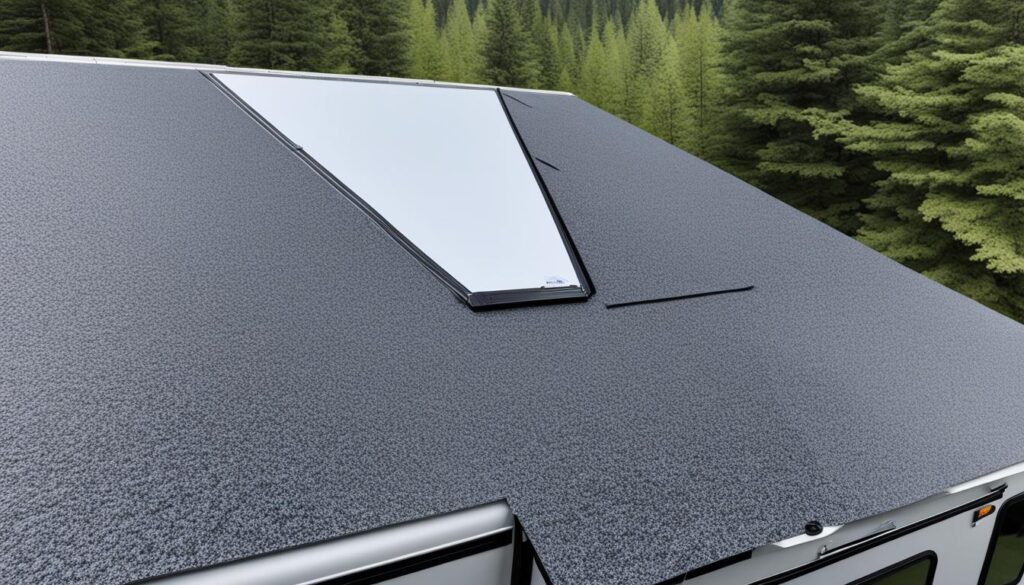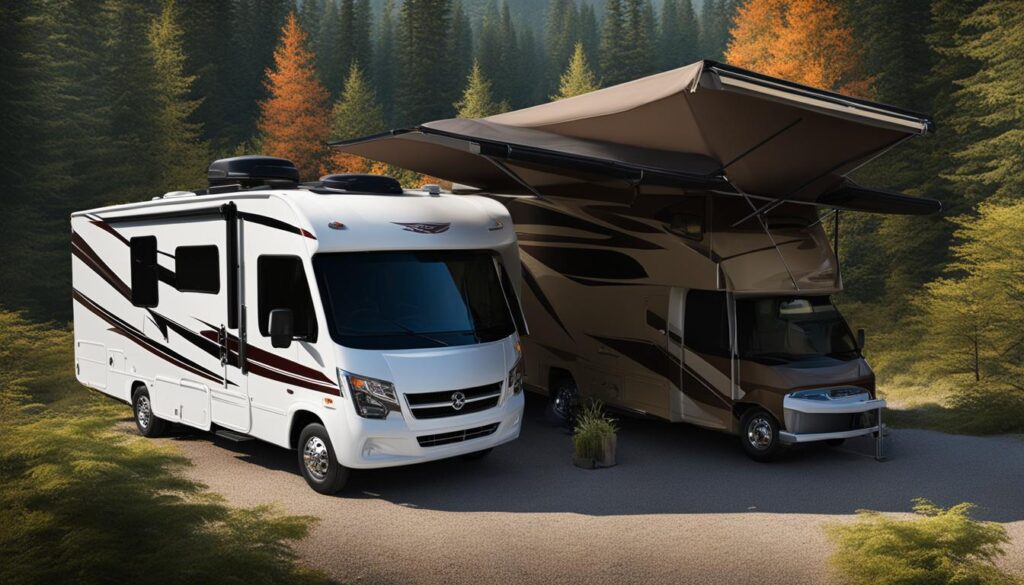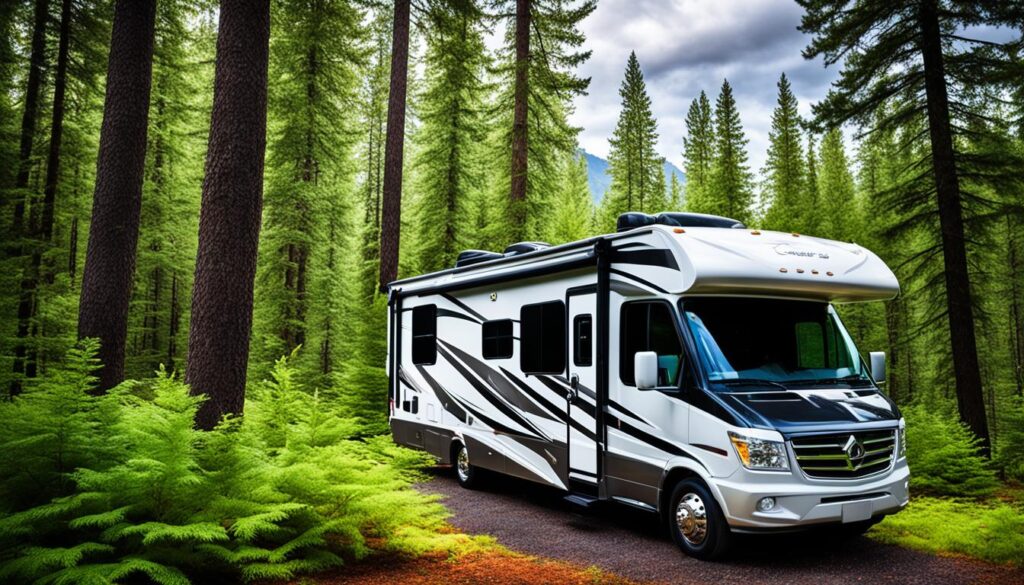When it comes to choosing the right roof material for your Forest River RV, there are a few options to consider. However, the decision often boils down to two popular choices: EPDM and TPO. These two materials offer durability, longevity, and resistance to harsh weather conditions. But which one is truly the best for your RV roof?
Key Takeaways:
- EPDM and TPO are both reliable options for Forest River RV roofs.
- EPDM is a rubber membrane roofing material made from recycled materials.
- TPO is a blend of synthetic rubber and polypropylene rolled out in a single layer for easy installation.
- EPDM roofs can last up to 50 years, while TPO roofs can last up to 30 years.
- TPO roofs are resistant to extreme temperatures, tearing, and punctures, while EPDM roofs offer flexibility and low cost.
Contents
Definition of TPO vs EPDM Roof
When it comes to choosing the right roof material for your Forest River RV, it’s important to understand the key differences between TPO and EPDM. TPO, or thermoplastic polyolefin, is a versatile roofing material that is rolled out in a single layer for easy installation. It is composed of a blend of synthetic rubber and polypropylene, offering both strength and flexibility. On the other hand, EPDM, or ethylene propylene diene monomer, is a synthetic rubber roofing material that can be found in liquid or sheet form. It is known for its durability and cost-effectiveness, mainly due to its recycled material composition.
TPO roofs are popular for their versatility in terms of shape and size, making them suitable for various RV designs. They can be easily installed and offer reliable protection against harsh weather conditions. On the other hand, EPDM roofs are highly flexible and can conform to different roof shapes seamlessly. Their low cost and ease of installation make them a preferred choice for many RV owners.
While both TPO and EPDM are excellent options for Forest River RV roofs, understanding their definitions and characteristics can help you make an informed decision based on your specific needs and preferences.
| TPO Roof | EPDM Roof |
|---|---|
| Easily installed | Flexible and conformable |
| Made from synthetic rubber and polypropylene blend | Made from a blend of ethylene and propylene |
| Versatile in shape and size | Offers cost-effectiveness |
Differences Between TPO Roofing vs EPDM
When it comes to choosing the right roof material for your Forest River RV, understanding the differences between TPO (thermoplastic polyolefin) and EPDM (ethylene propylene diene monomer) roofing is crucial. Not only can it impact the longevity and durability of your RV’s roof, but it can also affect the installation process and maintenance requirements. Let’s explore the key differences between TPO and EPDM roofing materials:
Longevity
One notable difference between TPO and EPDM roofing is their respective lifespans. TPO roofs can last up to 30 years, offering durability and peace of mind for the long term. EPDM roofs, on the other hand, have the potential to last up to 50 years when properly installed, providing even greater longevity.
Durability
TPO roofs are highly resistant to extreme temperatures, tearing, and punctures, making them an excellent choice for roofs exposed to impacts or harsh weather conditions. EPDM roofs, on the other hand, are known for their durability and hard-wearing nature. They have a high tensile strength and elasticity, ensuring they can withstand various weather elements with ease.
Installation Method
When it comes to installation, TPO roofs offer more flexibility in terms of installation methods. They can be installed using gluing, mechanical attachment, or ballasting, allowing for different approaches based on individual preferences and requirements. EPDM roofs, on the other hand, are typically installed using special adhesives, which may require specific expertise or techniques for proper application.
Maintenance
In terms of maintenance, both TPO and EPDM roofs require regular upkeep to ensure their longevity. TPO roofs may require occasional resealing to maintain their integrity and prevent leaks. EPDM roofs, on the other hand, require regular cleaning and patching of small holes or tears to prevent any potential water damage. By staying on top of maintenance tasks, you can maximize the lifespan and performance of both roof materials.
Summary
Overall, both TPO and EPDM roofing materials have their own unique features and advantages. TPO roofs offer excellent durability and longevity, with the flexibility of multiple installation methods. EPDM roofs, on the other hand, provide superior durability and a longer potential lifespan. When choosing between the two, consider factors such as climate, budget, and personal preferences to ensure you select the right roof material for your Forest River RV.
Pros and Cons of TPO vs EPDM RV Roof
When it comes to choosing the right roof material for your Forest River RV, it’s important to consider the pros and cons of TPO and EPDM roofing options. Both TPO and EPDM roofs have their advantages and disadvantages, and understanding them can help you make an informed decision for your RV roof material.
TPO Roof Pros
- High resistance to tears, impacts, and punctures
- Cost-effective in terms of maintenance and installation
- Offers better dimensional stability
- Stronger seam strength
TPO Roof Cons
- Relatively newer in the market with a shorter lifespan compared to other roofing materials
EPDM Roof Pros
- Known for longevity and low maintenance costs
- Flexible and durable
- Energy-efficient
EPDM Roof Cons
- Limited aesthetic choices
- Can be more challenging to install and repair compared to TPO roofs
Both TPO and EPDM roofs have their advantages and disadvantages, so it’s important to weigh them against your specific needs and preferences. TPO roofs offer excellent resistance to tears, impacts, and punctures, making them a durable choice for RV roofs. They are also cost-effective in terms of maintenance and installation, providing a good budget-friendly option. However, TPO roofs are relatively newer in the market and may have a shorter lifespan compared to other types of roofing materials.
On the other hand, EPDM roofs are known for their longevity and low maintenance costs. They are flexible, durable, and energy-efficient, providing excellent performance over the years. However, EPDM roofs have limited aesthetic choices and can be more challenging to install and repair compared to TPO roofs.
Ultimately, the choice between TPO and EPDM roofing for your Forest River RV will depend on your priorities, budget, and specific requirements.

| TPO Roof | EPDM Roof | |
|---|---|---|
| Resistance to tears, impacts, and punctures | High | Good |
| Cost-effectiveness (maintenance and installation) | Excellent | Good |
| Dimensional stability | Better | Good |
| Seam strength | Strong | Good |
| Lifespan | Shorter | Longer |
| Aesthetic choices | Various | Limited |
| Installation and repair difficulty | Easy | Challenging |
EPDM vs TPO Cost
When considering the best roof material for your Forest River RV, cost plays a crucial factor. Let’s compare the cost of TPO and EPDM roofing materials to help you make an informed decision.
TPO roofing, although highly durable and versatile, tends to be more expensive than EPDM roofing. The manufacturing process and additional materials required for TPO installation contribute to its higher price point. On average, TPO roll prices range from $3.50 to $14.00 per square foot.
On the other hand, EPDM roofing is known for being the most cost-effective option. With prices approximately ranging from $4.50 to $5.50 per square foot, EPDM roofing offers a budget-friendly alternative for Forest River RV owners.
However, it’s important to consider the thickness and quality of the roofing material when determining the overall cost. Investing in a higher quality EPDM or TPO roof may provide greater longevity and performance, ultimately saving you money in the long run.
Here’s a comparison of the cost of TPO vs EPDM roofing materials:
| TPO Roofing Cost (per square foot) | EPDM Roofing Cost (per square foot) |
|---|---|
| $3.50 – $14.00 | $4.50 – $5.50 |

As you plan your Forest River RV roof project, carefully consider your budget and the specific requirements of your RV to determine whether TPO or EPDM roofing is the most cost-effective option for you.
Installation and Maintenance
When it comes to installing a roof for your Forest River RV, the processes for TPO and EPDM roofs differ. TPO roofs offer versatility as they can be installed using various methods such as full adhesion, mechanical attachment, or ballasting. On the other hand, EPDM roofs are available in rolls or sheets and are applied to the roof surface using special adhesives.
Regardless of the roof material you choose, regular maintenance is crucial to ensure its longevity. TPO roofs may require periodic resealing to maintain their effectiveness in protecting your RV from environmental elements. EPDM roofs, on the other hand, need consistent cleaning and patching of any small holes or tears that may occur over time. By following these maintenance routines, you can enhance the performance and durability of both TPO and EPDM roofs for your Forest River RV.
Proper installation and regular upkeep of your chosen roof material are essential to safeguard your RV and prolong its lifespan. Whether you opt for TPO or EPDM, ensuring a professional installation and adhering to the manufacturer’s recommended maintenance guidelines will help you make the most of your investment in a reliable and durable roof for your Forest River RV.
FAQ
Which RV roof material is better: EPDM or TPO?
The choice between EPDM and TPO roof materials depends on your specific needs and preferences. Both materials offer durability and longevity, but they have some key differences. It is best to consider factors such as longevity, durability, installation method, maintenance requirements, and cost before making a decision.
What is the definition of TPO vs EPDM roof?
TPO stands for thermoplastic polyolefin and is a synthetic rubber and polypropylene blend rolled out in a single layer for easy installation. EPDM stands for ethylene propylene diene monomer and is a rubber membrane roofing material available in liquid or sheet form. Both materials are designed to withstand harsh weather conditions and offer flexibility and durability.
What are the differences between TPO and EPDM roofing?
TPO roofs have a longer lifespan of up to 30 years, while properly installed EPDM roofs can last up to 50 years. TPO roofs are resistant to extreme temperatures, tearing, and punctures, making them a good choice for roofs exposed to impacts. EPDM roofs are highly durable and offer flexibility and low cost due to their recycled material composition.
What are the pros and cons of TPO vs EPDM RV roofs?
TPO roofs offer high resistance to tears, impacts, and punctures. They are cost-effective in terms of maintenance and installation, offer better dimensional stability, and have stronger seam strength. However, TPO roofs may have a shorter lifespan compared to other types of roofing materials. EPDM roofs are known for their longevity and low maintenance costs, but they have limited aesthetic choices and can be more challenging to install and repair compared to TPO roofs.
How much does TPO and EPDM roofing cost?
The cost of TPO and EPDM roofing materials can vary. TPO roofing is generally more expensive than EPDM roofing due to the manufacturing process and additional materials required for installation. TPO roll prices can range from $3.50 to $14.00 per square foot, while EPDM roofing is generally the most inexpensive option, costing around $4.50 to $5.50 per square foot. It is important to consider the thickness and quality of the roofing material when determining the overall cost.
How are TPO and EPDM roofs installed and maintained?
TPO roofs can be installed using various methods such as full adhesion, mechanical attachment, or ballasting. EPDM roofs are available in rolls or sheets and are applied to the roof surface using special adhesives. Both types of roofs require regular maintenance to ensure their longevity. TPO roofs may require resealing, while EPDM roofs need cleaning and patching of small holes or tears. Proper installation and regular maintenance are key to the performance and durability of both TPO and EPDM roofs for Forest River RVs.






